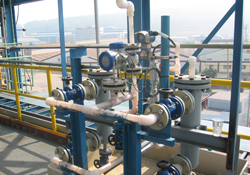Many marine species will be harmed or won't survive if the levels of carbon dioxide continue to increase.
Invasive species -- plants, animals, and microbes introduced to regions beyond their native range -- carry a global price tag of $1.4 trillion dollars. They are responsible for the loss of natural resources and biodiversity, damages to infrastructure, and an uptick in infectious diseases.
In settlement papers filed in federal district court, three companies have agreed to pay about $29.8 million in cleanup costs for a Superfund site in Fairmont, Marion County, W. Va., the U.S. Environmental Protection Agency (EPA) has announced.
A new analysis of complex interactions between humans and the environment preceding the 9th century collapse and abandonment of the Central Maya Lowlands in the Yucatán Peninsula points to a series of events -- some natural, like climate change; some human-made, including large-scale landscape alterations and shifts in trade routes -- that have lessons for contemporary decision-makers and sustainability scientists.
New scientific analysis strengthens the view that record-breaking summer heat, crop-withering drought and other extreme weather events in recent years do, indeed, result from human activity and global warming, Nobel Laureate Mario J. Molina, Ph.D., said at a conference in Philadelphia on August 20.
A federal jury today found House of Raeford Farms Inc., the owner and operator of a poultry slaughtering and processing facility located in Raeford, North Carolina, guilty of 10 counts of knowing violations of the Clean Water Act.
The Department of Justice and the U.S. Environmental Protection Agency have announced a settlement with two subsidiaries of Sinclair Oil Corporation to resolve alleged violations of air pollution limits established in a 2008 consent decree at refineries in Casper and Sinclair, Wyo.
Engineering researchers made a sheet of paper from the world’s thinnest material, graphene, and then zapped the paper with a laser or camera flash to blemish it with countless cracks, pores, and other imperfections. The result is a graphene anode material that can be charged or discharged 10 times faster than conventional graphite anodes used in today’s lithium (Li)-ion batteries.
Even though it sounds like science fiction, researchers are taking a second look at a controversial idea that uses futuristic ships to shoot salt water high into the sky over the oceans, creating clouds that reflect sunlight and thus counter global warming.
The report card provides information about the current and predicted-future state of Australia's marine climate and its impact on our marine biodiversity. The report card also outlines actions that are underway to help our marine ecosystems adapt to climate change.
Two new studies by scientists at UC Berkeley provide a clearer picture of why some species move in response to climate change, and where they go.
Most of the bacteria that remain in drinking water when it gets to the tap can be traced to filters used in the water treatment process, rather than to the aquifers or rivers where it originated, University of Michigan researchers discovered.

Electromagnetic flowmeters (EMFs) are the leading choice for recording the volume flow of electrically conductive liquids in a wide range of industries, including chemical, pharmaceutical, water/wastewater and food.
The authors of a Harvard study published August 19 in Nature Climate Change gathered their data from an unlikely source -- the trip accounts of the Massachusetts Butterfly Club.
A new “Wind Technologies Market Report” from the U.S. Department of Energy shows how quickly the installation of wind energy equipment progressed in the United States during 2011.
A shipping company headquartered in Italy and the chief engineer of one of its ships were sentenced today in federal court in Mobile, Ala., for deliberately falsifying records to conceal discharges of oily wastewater from the ship directly into the sea.
Renewable energy technologies generally consist of two distinct processes: energy generation (using sources such as coal, solar, wind, etc.) and energy storage (such as batteries).
The report card provides information about the current and predicted-future state of Australia's marine climate and its impact on our marine biodiversity. The report card also outlines actions that are underway to help our marine ecosystems adapt to climate change.
Engineers at a company co-founded by a University of Texas at Dallas professor have identified a material that can reduce the pollution produced by vehicles that run on diesel fuel.
A new carbon cycling model developed at the U.S. Department of Energy's (DOE) Oak Ridge National Laboratory better accounts for the carbon dioxide-releasing activity of microbes in the ground, improving scientists' understanding of the role soil will play in future climate change.